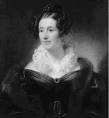Mary Fairfax Greig Somerville 1780 - 1872
April 29, 2009
 Mary
**Fairfax **Greig
**Somerville** 1780
Mary
**Fairfax **Greig
**Somerville** 1780
- 1872 was a Scottish science writer and polymath, at a time when women’s participation in science was discouraged.
Somerville was a friend of Charles Babbage, Barbara Leigh Smith Bodichon, Mary Everest Boole, John Herschel, and Harriet Martineau.
Somerville was also an active feminist.
She studied mathematics and astronomy, and was the second woman scientist to receive recognition in the United Kingdom after Caroline Herschel.
She was the daughter of William George Fairfax, and was born at the manse of Jedburgh, in the Borders, the house of her mother’s sister, wife of Thomas Somerville (1741–1830), author of My Own Life and Times.
In 1804 she married her distant cousin, the Russian Consul in London, Captain Samuel Greig, son of Samuel Greig. They had two children before Samuel Greig died in 1807, one of whom, Woronzow Greig became a barrister and scientist.
After the death of her husband the inheritance gave her the freedom to pursue intellectual interests. In 1812 she married another cousin, William Somerville (1771–1860), inspector of the Army Medical Board, who encouraged and greatly aided her in the study of the physical sciences. They had a further four children.
After her marriage she made the acquaintance of the most eminent scientific men of the time, among whom her talents had attracted attention before she had acquired general fame, Pierre Simon de Laplace told her “There have been only three women who have understood me. These are yourself, Mrs. Somerville, Caroline Herschel and a Mrs. Grieg of whom I know nothing.” (Of course, Somerville was first and third of these three.)
Having been requested by Henry Peter Brougham 1st Baron Brougham and Vaux to translate for the Society for the Diffusion of Useful Knowledge the Mécanique Céleste of Pierre Simon de Laplace, she greatly popularized its form, and its publication in 1831, under the title of The Mechanism of the Heavens, at once made her famous. She stated “I translated Laplace’s work from algebra into common language”.
Her other works are the On the Connexion of the Physical Sciences (1834), Physical Geography (1848), and Molecular and Microscopic Science (1869). In 1835, she and Caroline Herschel became the first women members of the Royal Astronomical Society. In 1838 she and her husband went to Italy, where she spent much of the rest of her life.
Much of the popularity of her writings was due to her clear and crisp style and the underlying enthusiasm for her subject which pervaded them. From 1835 she received a pension of £300 from government.
She died at Naples on 28 November 1872, and is buried there in the English Cemetery, Naples.
In the following year there appeared her autobiographical Personal Recollections, consisting of reminiscences written during her old age, and of great interest both for what they reveal of her own character and life and the glimpses they afford of the literary and scientific society of bygone times. She also invented the commonly used variables from algebraic math.
Somerville College, Oxford, was named after Mary Somerville, as is Somerville House, Burntisland, where she lived for a time. The term “scientist” was first coined by William Whewell in an 1834 review of her On the Connexion of the Sciences.
Somerville Island (74°44’N, 96°10’W), a small island in Barrow Strait, Nunavut, was named after her by William Edward Parry in 1819 during the first of the four Arctic expeditions under his command.
5771 Somerville (1987 ST1) is a Main belt Asteroid discovered on September 21, 1987 by E. Bowell at Lowell Observatory Flagstaff, Arizona, and named for her.
Somerville_(crater) is a small lunar crater in the eastern part of the Moon. It lies to the east of the prominent crater Langrenus, and was designated Langrenus J before being given her name by the International Astronomical Union. It is one of a handful of lunar craters named after a woman.